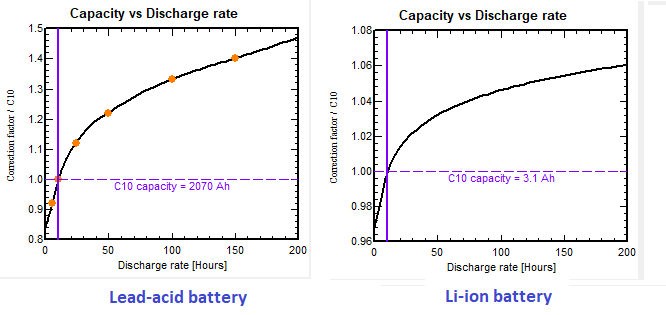|
<< Click to Display Table of Contents >> Capacity as function of discharge rate |
  
|
|
<< Click to Display Table of Contents >> Capacity as function of discharge rate |
  
|
(see also "Batteries, general considerations")
The capacity is defined as the cumulated current (expressed in [Ah] delivered by a fully charged battery up to its complete discharge.
This capacity is dependent on the instantaneous current value. The capacity corresponding to a discharge at constant current in 10 hours will be named C10.
The discharge rate [hours] is the time for a full discharge.
The discharge current rate [A] is the corresponding constant current.
Lead-acid batteries
The real capacity is highly dependent on the discharging rate. A discharge in 100 hours will usually gives 30 to 35% more capacity (C100) as a discharge in 10 hours (C10).
Now most of the Lead-acid batteries (for example for car starting) are specified with C10.
However usual stand-alone solar systems involve rates of the order of 20 to 100 hours (a full charge corresponding to 3-4 days of use). Therefore many manufacturers specify the nominal capacity of their batteries as C100 instead of C10 !
In PVsyst we have adopted the convention that the nominal capacity is always C10.
Now for lead-acid batteries, all manufacturers specify a set of capacities at different rates, ranging usually between C5 and C200. These operating data are recorded in the PVsyst database as a cubic profile.
Li-Ion batteries
The capacity dependency is far lower, and rarely explicitly specified by the manufacturers.
In PVsyst we use a parametrization based on one only parameter: the Peukert coefficient, which is of the order of 1.02 for most Li-Ion batteries. This leads to a ratio of less than 5% between C100 and C10.
Now the Li-Ion batteries are often used (and suited) for very high current rates (car charging, grid peak-shaving, computers, etc). Therefore the nominal capacities are often expressed as C2 or C5. There is a tool on the main page for retrieving the corresponding C10 parameter required by PVsyst.
NB: the Peukert parametrization is perfectly applicable to the Lead-acid batteries: this corresponds to a Peukert coefficient of 1.12 to 1.13.


This tool allows to see the Capacity as a correction factor (with respect to C10) or the real capacity.
It is also possible to show the capacity evolution as a function of the current rate [A]